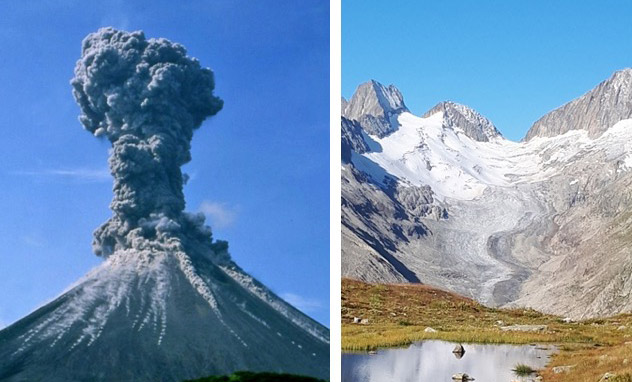Navigation auf uzh.ch
Navigation auf uzh.ch
Large volcanic eruptions were thought to lead to a mass gain and an advance of glaciers worldwide. Whether this could happen again under current climatic changes was investigated by Michael Zemp, glaciologist at GIUZ, and Ben Marzeion, climate scientist at the University of Bremen.

When a volcano erupts, enormous quantities of ash and sulfur gases are injected into the atmosphere. These influence the global climate due to a shading effect of the volcanic aerosols on the incoming sunlight and can lead to a mass gain and an advance of glaciers. Since the mid-20th century, however, the relevance of volcanic eruptions has become less important due to the sharp rise in greenhouse gas concentrations.
The present study examined the relationship between glacier changes from 1961 to 2005 and observations of human-released greenhouse gases, volcanic and sun activities, and a phenomenon related to ocean temperatures called the El Niño-Southern Oscillation. Global glacier mass loss was mainly caused by the increase in anthropogenic greenhouse gases, interrupted by only a few years of mass re-gain after large volcanic eruptions.
With increasing greenhouse gas concentrations, however, the relevance of volcanic eruptions is dwindling. In the paper, this illustrated at the example of Mount Pinatubo, a volcano in the Philippines. The eruption in 1991 was the largest volcanic eruption of the 20th century and managed to pause glacier melting at global level for one year. In a modelling experiment, the authors repeated the Pinatubo eruption at 45-years intervals in 1856, 1901, 1946, 1991, and 2036.
This experiment clearly demonstrates the dwindling relevance of volcanic eruptions for the global net balance of glaciers. While the hypothetic eruptions in the 19th century resulted in distinct periods of global mass gain over a few years, a repetition of the Pinatubo eruption in 2036 would be nowhere near able to compensate for the ice loss due to anthropogenic forcings. For this future scenario, an event with two to three times the radiative effect of the Pinatubo eruption would be required for a global net mass gain of glaciers.
Zemp, M., & Marzeion, B. (2021). Dwindling relevance of large volcanic eruptions for global glacier changes in the Anthropocene. Geophysical Research Letters, 48, e2021GL092964.
Communications